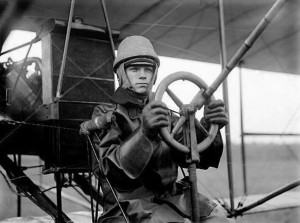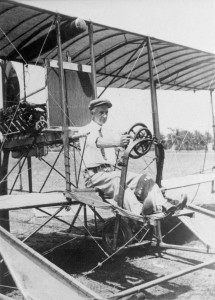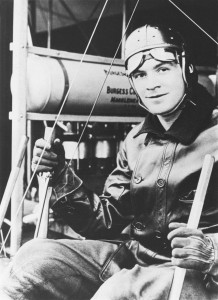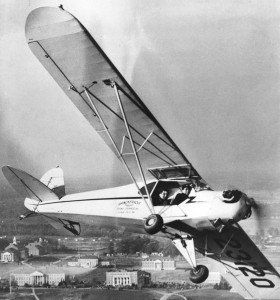Published on September 7, 2012
“Learning Fast. WRIGHT SOARS WITH PUPILS. Lieuts. Lahm and Humphreys Handle Flyer. Each Takes Three Flights with Instructor. More difficult Maneuvers Will Be Taught.”
On this date in aviation history, September 7, 1909, officers from the US Army were at work opening the military’s first “aerodrome” at College Park, Maryland. The lease for the site, located just north of Washington, DC, had been signed on August 25, 1909. With the word that the first aeroplane was being shipped in, they began to prepare the field in earnest and soon afterward, the newly acquired modified Wright Model A, the “1909 Military Flyer” arrived. On October 7, it was assembled for a first flight and on October 15, with Wilbur Wright personally at the controls, the Army’s newest aeroplane would make its first flight. With that, the aerodrome commenced formal operations — and it has never closed since, making it the oldest continuously operational airport in the world.

First Flights from College Park
The first flights at College Park were undertaken as part of the Army’s contract to train two military pilots, Lieutenants Frederic Humphreys and Frank Lahm. They learned quickly and after just a few weeks and a handful of hours at the controls, were certified as licensed military aviators. It would fall to them and to the other Army pilots who had been taught the previous year at Ft. Myers to train the rest of the first generation of military aviators.

By 1910, the Rex Smith Aeroplane Company opened its doors at College Park, inaugurating civilian aviation operations at the site. Given the expansion underway of Army flying too, by 1911, the US Army had established its first formal flight school on the airport. Two Army pilots served as instructors on the Wright Aeroplanes, these being Lt. Henry H. “Hap” Arnold and Lt. Thomas DeWitt Milling. An Army-owned Curtiss aeroplane was also used for training under the tutelage of Captain Paul W. Beck. Many of the early pilots that emerged as the leaders of Army aviation thus earned their wings at College Park.

Aviation Firsts at College Park
Over the years, the airport grew and soon became known as the nation’s cradle of aviation. Along the way, many impressive “firsts” in aviation history happened at College Park, including:
- The world’s first military airfield and military training facility in 1909
- The first dedicated air mail base, which served Philadelphia and New York, commencing in 1918
- The site of Emile and Henry Berliner’s first helicopter flights in 1920
- The development of instrument flying from 1927 to 1933
- The creation of the Ercoupe, the world’s first “unspinnable” airplane.

For over thirty years starting in 1927, the Brinckerhoff Flying Service, under the leadership of George Brinckerhoff, operated the FBO at the field. Under his management, the airport flourished and many pilots learned to fly there. He began also a tradition of holding airshows at the airport, which attracted pilots from around the nation as well numerous spectators from the Washington, DC, area.

Modern Times and Issues
The greatest threat to College Park Airport’s existence came in the wake of the terrorist attacks of September 11. A small civilian airport located so close to the Capitol was seen as a potential threat. For a time, the airport was open only to government aircraft but then finally, a reasonable compromise solution was worked out allowing civilian aircraft to fly from the airport. Today, pilots flying to and from College Park are required to undergo a one-time background check. The forms and application processes are outlined on the College Park Airport website and are easy to fill out. The security risk has been addressed with a reasonably easy form — not bad for government work!

If you ever get a chance to fly up to Washington, DC, you should definitely make application and take a flight there. It is a historic place and, other than Kitty Hawk, it ranks as the nation’s top historic airport destination. While you’re there, be sure you check out one of the nation’s nicest small aviation museums, located right on the field — the College Park Aviation Museum.
Links of Interest:
College Park Airport Website
College Park Aviation Museum
Landing at College Park in a Cherokee 140
One More Bit of Aviation History Trivia
The Washington, DC, area hosts four major airports — Dulles International, Washington Reagan National Airport, Baltimore-Washington International, and Andrews AFB. In addition, numerous small airports serve general aviation traffic are in the region. In fact, there is no shortage of airports in the area. Thus, it remains something of a mystery why College Park was singled out for potential closure in the wake of September 11 — indeed, a flight taking off from other nearby airports, such as Manassas, could arrive over the Capitol Building in almost the same amount of time. Further, in 1994, when a private plane was crashed into the White House South Lawn, it had originated from father away. On board was an intoxicated and suicidal pilot whose wife had recently left him — he flew from well over an hour farther north of College Park Airport, from Harford County Airport in Churchville, Maryland, to make headlines with his final act, using a stolen airplane. With today’s coverage, it would be difficult, if not impossible to repeat the act.
Today’s Aviation History Question
What famous aviation innovator landed his airplane on the Capitol grounds and taxied up to the steps to ask the US Congress about an unpaid bill?

Sounds like something that Howard Hughes would do.
Answer: Wilbur Wright
It might be of interest how dangerous flying was then, particularly in Wright Flyers. Eight of the first 14 U.S. military pilots were killed in them in the first 16 months of activity.